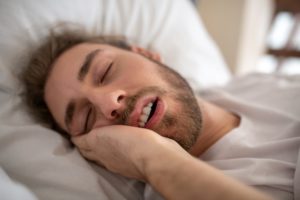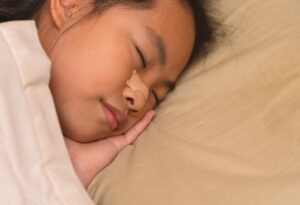Snoring in Children
- Light childhood snoring is normal, but the frequency, severity, and impact of childhood snoring can vary.
- Risk factors that can cause snoring in toddlers and babies include swollen tonsils and adenoids, congestion, anatomy, and air quality.
- Sleep-disordered breathing in children can affect sleep quality and may have serious health consequences, depending on severity.
- Caregivers who are worried about their child’s snoring should talk to their pediatrician and watch for signs of breathing conditions.
Even though snoring is most common among older adults , it occurs in many children as well. It can have many causes, some of which cause snoring to come and go and others that are potentially long-lasting.
Snoring in children is often of little concern, especially if it only happens every once in a while. But if snoring is frequent or severe, it may signal a problem of disturbed breathing during sleep.
Knowing more about the types, causes, consequences, and treatments of snoring in children can allow parents to best look out for the health of their children and help kids get better, more restorative sleep.
Is All Snoring in Children the Same?
Not all snoring in children is the same. The frequency, severity, and impact of snoring in children can vary significantly.
Most of the time, snoring is minor and short-lived with no measurable effect on the person’s sleep or overall health. When snoring becomes more frequent and interrupts sleep, it can indicate the presence of sleep-disordered breathing (SDB) .
Sleep-disordered breathing ranges in seriousness. On one end is primary snoring, also known as simple snoring or habitual snoring, when a child snores more than two times per week but does not have other noticeable symptoms or associated health issues.
On the other end is obstructive sleep apnea (OSA), a condition marked by constant lapses in a child’s breath during the night. Those lapses, called apneas, occur dozens of times per night when the airway becomes blocked. OSA can cause fragmented sleep and is connected with negative impacts on physical health, mental health, learning, and behavior.
Is Your Childs Snoring a Health Risk?
Answer three questions to understand if you should be concerned.
How Common Is Snoring in Children?
Minor, occasional snoring is believed to occur in up to 27% of children . This type of light, temporary snoring does not usually raise health concerns.
Primary snoring without other symptoms is thought to affect between 10 and 12% of children . Studies estimate that 1.2-5.7% of children have obstructive sleep apnea. Of children diagnosed with sleep-disordered breathing, around 70% receive a diagnosis of primary snoring .
It is hard to determine exact statistics for snoring and sleep apnea. Parents may not always observe their child’s snoring or be aware of its frequency and severity. In addition, detailed testing for sleep apnea, known as polysomnography, may not be available, affordable, or practical in all cases.
What Causes Snoring in Children?
Snoring happens when air cannot flow freely through the airway at the back of the throat. As a person inhales or exhales, tissue around the airway vibrates , creating an audible noise.
Multiple factors can create blockages of the airway and cause a person to snore. In children, the most common risk factors for snoring include:
- Large or swollen tonsils and adenoids: The tonsils and adenoids are found near the back of the throat, and they are part of the body’s immune system. If they are naturally larger or are swollen because of infection, the tonsils and adenoids can obstruct the airway and cause snoring. This is the most common cause of sleep-disordered breathing in children.
- Obesity: Studies have found that children who are overweight are more likely to snore . Obesity can narrow the airway and raise the risk for SDB including obstructive sleep apnea.
- Congestion: Cold-like symptoms can cause congestion that blocks the smooth flow of air, and infection may inflame the tonsils and adenoids.
- Allergies: Flare-ups of allergies can cause inflammation in the nose and throat that can make it harder to breathe and raise the risk of snoring.
- Asthma: Like allergies, asthma may inhibit normal breathing, and if it causes partial blockages of the airway, can provoke snoring.
- Anatomic characteristics: Some people have anatomic characteristics that make it harder for them to breathe normally when sleeping. For example, a deviated septum , in which the nostrils are not separated equally, may cause mouth-breathing and snoring.
- Environmental tobacco smoke (ETS): Exposure to ETS, often referred to as secondhand smoke, can affect breathing and has been correlated with a higher risk of snoring in children.
- Contaminated air: Low air quality or excess contaminants can pose a challenge to normal respiration and may influence a child’s chances of frequent snoring.
- Shorter duration of breastfeeding: Research has found an association between snoring in children and reduced duration of breastfeeding. The exact reason for this is unknown, but it may be that breastfeeding helps the upper airway develop in a way that cuts down on the likelihood of snoring.
Obstructive sleep apnea is another important risk factor for childhood snoring. It is typical for children with obstructive sleep apnea to snore, including with gasp-like pauses in breath. While most children with OSA snore, not all children who snore have OSA.

Is Snoring in Children Dangerous?
Infrequent snoring in children is not usually dangerous, but regular or severe snoring that is indicative of sleep-disordered breathing can have significant health consequences.
Of the greatest concern is obstructive sleep apnea. OSA causes major sleep disturbances and affects the amount of oxygen a child receives during sleep. It has been connected to impaired brain development, reduced academic performance, cardiovascular issues like high blood pressure, altered metabolism, and behavior problems.
On the whole, it is clear that OSA can seriously affect a child’s quality of life . The impacts of OSA have been studied primarily in older children, but researchers believe that they also extend to young kids, such as 2-3 year-olds.
Traditionally, primary snoring that did not rise to the level of OSA was thought of as benign, but recent research has indicated that habitual snoring also carries health risks . Issues of cognitive impairment and behavior problems have been found to occur more in children with primary snoring than in those who never or rarely snore. Regular snoring may affect the nervous system and have negative effects on cardiovascular health.
Though studies have found a link between habitual snoring and health problems, the exact explanation is unclear. Further research is necessary to better understand the ways that primary snoring affects children of different ages.
What Are Signs That Snoring in Children Could Be a Sign of a Bigger Problem?
Parents who are worried about their child’s snoring should talk with a pediatrician. Though some snoring can be normal, various signs can indicate the possibility of sleep-disordered breathing or another sleep disorder:
- Snoring three nights per week or more
- Gasps or difficulty breathing while sleeping
- Bedwetting
- Bluish skin
- Morning headaches
- Daytime sleepiness
- Difficulty concentrating or learning
- Diagnosis of attention-deficit/hyperactivity disorder (ADHD)
- Below-average weight gain ( failure to thrive )
- Obesity
It is important to note that these factors can be indicators of SDB, but not all children who snore and have these issues necessarily have a more serious breathing condition.
What Can Help Reduce Snoring in Children?
Light, infrequent snoring usually goes away quickly on its own. Even habitual snoring can resolve on its own without treatment for many children. However, in many cases, taking steps to prevent sleep-disordered breathing is important for a child’s health.
Talk With a Doctor
A first step in reducing snoring in children is to bring up the issue with their doctor. Many pediatricians will proactively ask about snoring, and parents should be open about their concerns.
A doctor can look for signs of more serious sleep-disordered breathing or other factors, such as asthma or allergies, that could be contributing to snoring. They may recommend additional testing, such as with an overnight sleep study, to look for obstructive sleep apnea.
A clear diagnosis can help determine the best way to decrease snoring, and the doctor will be in the best position to discuss the benefits and downsides of different treatment options.
Surgery
Surgery to remove the tonsils and adenoids, known as adenotonsillectomy, is one of the main treatments for children with sleep-disordered breathing. It is most often considered for children with severe sleep apnea, but it may be an option for some with primary snoring. By eliminating the tissue that most frequently blocks the airway, this surgery can reduce snoring and pauses in breathing at night.
Positive Airway Pressure Devices
A positive airway pressure (PAP) device channels pressurized air through a mask and into the mouth and airway to prevent obstruction. Most PAP devices are either continuous (CPAP) or bi-level (BiPAP) based on how they control the flow of air.
While PAP devices are common for treating OSA in adults, in children they are usually reserved for OSA that persists after surgery to remove the tonsils and adenoids.
Sleep Hygiene
A way of helping children sleep better is by taking steps to improve their sleep hygiene, which includes their sleep-related habits and environment. Examples of sleep hygiene improvements include setting a consistent sleep schedule, reducing light exposure and screen time before bed, and setting up their bedroom to be as quiet and comfortable as possible.
While these steps for snoring in children are more like home remedies than medical treatments, they may be beneficial. For children who snore, poor sleep hygiene may exacerbate the risk of fragmented sleep and corresponding problems related to behavior, thinking, and health.

Still have questions? Ask our community!
Join our Sleep Care Community — a trusted hub of sleep health professionals, product specialists, and people just like you. Whether you need expert sleep advice for your insomnia or you’re searching for the perfect mattress, we’ve got you covered. Get personalized guidance from the experts who know sleep best.
References
19 Sources
-
Wolkove, N., Elkholy, O., Baltzan, M., & Palayew, M. (2007). Sleep and aging: 1. Sleep disorders commonly found in older people. CMAJ : Canadian Medical Association journal = journal de l’Association medicale canadienne, 176(9), 1299–1304.
https://pubmed.ncbi.nlm.nih.gov/17452665/ -
Smith, D. L., Gozal, D., Hunter, S. J., & Kheirandish-Gozal, L. (2017). Frequency of snoring, rather than apnea-hypopnea index, predicts both cognitive and behavioral problems in young children. Sleep medicine, 34, 170–178.
https://pubmed.ncbi.nlm.nih.gov/28522088/ -
Zhang, G., Spickett, J., Rumchev, K., Lee, A. H., & Stick, S. (2004). Snoring in primary school children and domestic environment: a Perth school based study. Respiratory research, 5(1), 19.
https://pubmed.ncbi.nlm.nih.gov/15527500/ -
Vlastos, I., & Athanasopoulos, I. (2016). Cutting-edge technologies for diagnosis and monitoring of snoring in children. World journal of clinical pediatrics, 5(1), 63–66.
https://pubmed.ncbi.nlm.nih.gov/26862503/ -
Biggs, S. N., Nixon, G. M., & Horne, R. S. (2014). The conundrum of primary snoring in children: what are we missing in regards to cognitive and behavioural morbidity?. Sleep medicine reviews, 18(6), 463–475.
https://linkinghub.elsevier.com/retrieve/pii/S1087079214000732 -
MedlinePlus: National Library of Medicine (US). (2016, August 4). Snoring.
https://medlineplus.gov/snoring.html -
Biggs, S. N., Walter, L. M., Jackman, A. R., Nisbet, L. C., Weichard, A. J., Hollis, S. L., Davey, M. J., Anderson, V., Nixon, G. M., & Horne, R. S. (2015). Long-Term Cognitive and Behavioral Outcomes following Resolution of Sleep Disordered Breathing in Preschool Children. PloS one, 10(9), e0139142.
https://pubmed.ncbi.nlm.nih.gov/26418065/ -
Li, S., Jin, X., Yan, C., Wu, S., Jiang, F., & Shen, X. (2010). Habitual snoring in school-aged children: environmental and biological predictors. Respiratory research, 11(1), 144.
https://pubmed.ncbi.nlm.nih.gov/20955625/ -
American Academy of Otolaryngology–Head and Neck Surgery Foundation. (2018, August). Deviated Septum.
https://www.enthealth.org/conditions/deviated-septum/ -
Weinstock, T. G., Rosen, C. L., Marcus, C. L., Garetz, S., Mitchell, R. B., Amin, R., Paruthi, S., Katz, E., Arens, R., Weng, J., Ross, K., Chervin, R. D., Ellenberg, S., Wang, R., & Redline, S. (2014). Predictors of obstructive sleep apnea severity in adenotonsillectomy candidates. Sleep, 37(2), 261–269.
https://pubmed.ncbi.nlm.nih.gov/24497655/ -
Beebe, D. W., Rausch, J., Byars, K. C., Lanphear, B., & Yolton, K. (2012). Persistent snoring in preschool children: predictors and behavioral and developmental correlates. Pediatrics, 130(3), 382–389.
https://pubmed.ncbi.nlm.nih.gov/22891224/ -
Marcus, C. L., Brooks, L. J., Draper, K. A., Gozal, D., Halbower, A. C., Jones, J., Schechter, M. S., Sheldon, S. H., Spruyt, K., Ward, S. D., Lehmann, C., Shiffman, R. N., & American Academy of Pediatrics (2012). Diagnosis and management of childhood obstructive sleep apnea syndrome. Pediatrics, 130(3), 576–584.
https://publications.aap.org/pediatrics/article/130/3/576/30284/Diagnosis-and-Management-of-Childhood-Obstructive -
Hornero, R., Kheirandish-Gozal, L., Gutiérrez-Tobal, G. C., Philby, M. F., Alonso-Álvarez, M. L., Álvarez, D., Dayyat, E. A., Xu, Z., Huang, Y. S., Tamae Kakazu, M., Li, A. M., Van Eyck, A., Brockmann, P. E., Ehsan, Z., Simakajornboon, N., Kaditis, A. G., Vaquerizo-Villar, F., Crespo Sedano, A., Sans Capdevila, O., von Lukowicz, M., … Gozal, D. (2017). Nocturnal Oximetry-based Evaluation of Habitually Snoring Children. American journal of respiratory and critical care medicine, 196(12), 1591–1598.
https://pubmed.ncbi.nlm.nih.gov/28759260/ -
Brockmann, P. E., Urschitz, M. S., Schlaud, M., & Poets, C. F. (2012). Primary snoring in school children: prevalence and neurocognitive impairments. Sleep & breathing = Schlaf & Atmung, 16(1), 23–29.
http://link.springer.com/10.1007/s11325-011-0480-6 -
Lopes, M. C., Spruyt, K., Azevedo-Soster, L., Rosa, A., & Guilleminault, C. (2019). Reduction in Parasympathetic Tone During Sleep in Children With Habitual Snoring. Frontiers in neuroscience, 12, 997.
https://pubmed.ncbi.nlm.nih.gov/30686970/ -
A.D.A.M. Medical Encyclopedia [Internet]. Atlanta (GA): A.D.A.M., Inc.; c1997-2019. Failure to thrive.
https://medlineplus.gov/ency/article/000991.htm -
Ali, N. J., Pitson, D., & Stradling, J. R. (1994). Natural history of snoring and related behaviour problems between the ages of 4 and 7 years. Archives of disease in childhood, 71(1), 74–76.
https://pubmed.ncbi.nlm.nih.gov/8067797/ -
Borovich, A., Sivan, Y., Greenfeld, M., & Tauman, R. (2016). The history of primary snoring in children: the effect of adenotonsillectomy. Sleep medicine, 17, 13–17.
https://linkinghub.elsevier.com/retrieve/pii/S1389945715020110 -
Witcher, L. A., Gozal, D., Molfese, D. M., Salathe, S. M., Spruyt, K., & Crabtree, V. M. (2012). Sleep hygiene and problem behaviors in snoring and non-snoring school-age children. Sleep medicine, 13(7), 802–809.
https://pubmed.ncbi.nlm.nih.gov/22647496/










